|
Steel Jewellery after the Collapse of the Buckle
Trade
Shoe buckles died out except for court dress and, in some
regiments, for full dress uniform. But that does not mean that cut steel
jewellery died out. It continued to be made in quantities. Steel shoe
buckles continued in some use, though their presence tend to be hidden
by the purists' insistence that what the Victorians thought of as shoe
buckles were not buckles at all but mere stitched on ornament with no
practical function. But in 1873 "A Lady" writing on "How to Dress well
on £15 a Year" says that "Good steel buckles will always look nice".
 |
A card (early 20th century?) with stamped brass "shoe
ornaments" with faceted steel studs. |
How much of this later steel jewellery was made in
Wolverhampton is not known. Bury says that "Cut steel was still being
manufactured in London at the time of the Great Exhibition, although
probably only in small quantities". The French were largely
responsible for developments in production methods and seem to have made
most of the later steel jewellery, though Germany also seems to have
been a centre of production. Even so Bury gives the names of a
number of British makers (in Birmingham or London) who lasted through a
greater part of the nineteenth century and even, in the case of James
Heeley and Sons, into the 20th century. None of those she lists
comes from Wolverhampton.
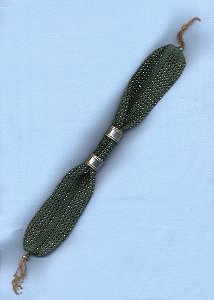 |
Steel beads continued to be widely used, as in this
example of a "miser's purse", made in cotton, with steel
beads and steel ring closures. |
| In addition to steel beads, purses often had a
decorative fringe or a finial drop made, as here, of a large
steel bead. The clasp is made of steel and was
sometime decorated with studs. The body of the purse
is crocheted in cotton. |
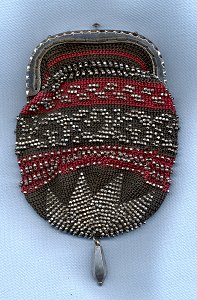 |
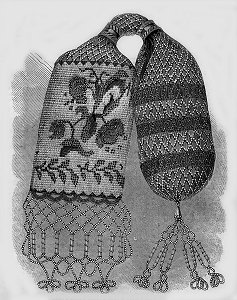 |
This diagram of a "bridal purse" appeared in the
Illustrated Exhibitor and Magazine of Art in 1852 in a
section headed "The Ladies' Department". The
instructions for making it (crocheted in white, scarlet and
slate silk) called for various coloured beads and "a hank of
steel" - that is, of steel beads already threaded. |
Bury also says that steel jewellery was "in high fashion
several times during the second half of the [nineteenth] century, quite
apart from its usefulness in secondary mourning." These times of
these revivals include the late 1850s and a period about 1882. At
about that latter time there was also a revival of shoe buckles which,
Bury thinks, Kate Greenaway's book illustrations contributed to.
| A stamped buckle - note the tear drop shapes which
would have been tricky to produce in the solid. This
is probably late 19th century. |
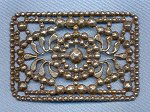 |
 |
An identical buckle covered with black japanning,
making it suitable for mourning wear. Steel jewellery,
in its polished state, was considered acceptable for half
mourning. |
Apart from the stamped pieces, steel jewellery seems to
have been put together in the traditional way, and steel studs were
sometime incorporated in jewellery made in other materials but were
still usually rivetted in and not treated like stones.
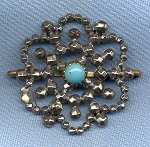 |
Brooches with an artificial turquoise and
rivetted studs; and artificial pearls with steel beads. |
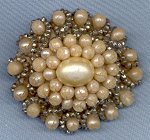 |
It might be noted that the images which decorate these
web pages (which are, except where otherwise attributed, from a private
collection in Wolverhampton) are probably mostly from this later
Victorian period.
|

